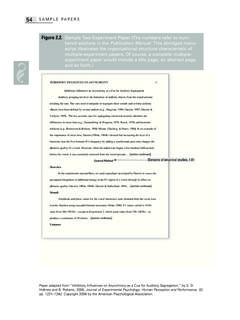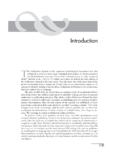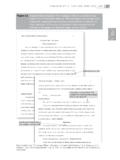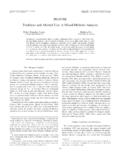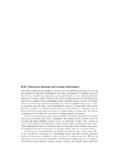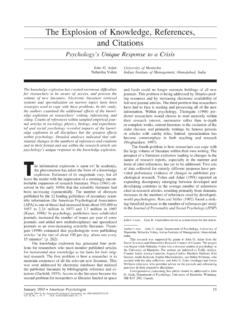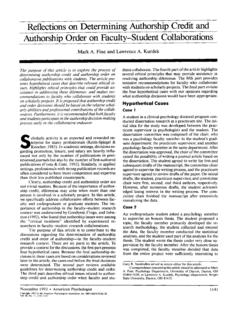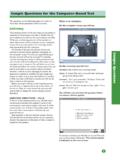Transcription of Sample One-Experiment Paper (The numbers refer …
1 MANUSCRIPT STRUCTURE AND CONTENT 41. Figure Sample One-Experiment Paper (The numbers refer to numbered sections in the Publication Manual.). Running head: EFFECTS OF AGE ON DETECTION OF EMOTION 1. Establishing a title, ; Preparing the manuscript for submission, Effects of Age on Detection of Emotional Information Christina M. Leclerc and Elizabeth A. Kensinger Boston College Formatting the author name (byline) and institutional affiliation, , Table Elements of an author note, Author Note Christina M. Leclerc and Elizabeth A.
2 Kensinger, Department of Psychology, EFFECTS OF AGE ON DETECTION OF EMOTION 2. Boston College. arch was supported by National Science Foundation Grant BCS. This research 0542694. Abstract Writing the abstract, beth A. Kensinger. awarded to Elizabeth Age differences were examined in affective processing, in the context of a visual search task. ndence concerning this article should be addressed to Christina M. Leclerc, Correspondence Young and older adults were faster to detect high arousal images compared with low arousal and sychology, Boston College, McGuinn Hall, Room 512, 140 Commonwealth Department of Psychology, neutral items.
3 Younger adults were faster to detect positive high arousal targets compared with ut Hill, MA 02467. Email: Avenue, Chestnut other categories. In contrast, older adults exhibited an overall detection advantage for emotional images compared with neutral images. Together, these findings suggest that older adults do not display valence-based effects on affective processing at relatively automatic stages. Keywords: aging, attention, information processing, emotion, visual search Double-spaced manuscript, Times Roman typeface, 1-inch margins, Paper adapted from Effects of Age on Detection of Emotional Information, by C.
4 M. Leclerc and E. A. Kensinger, 2008, Psychology and Aging, 23, pp. 209 215. Copyright 2008 by the American Psychological Association. 42 S A M P L E PA P E R S. Figure Sample One-Experiment Paper (continued). EFFECTS OF AGE ON DETECTION OF EMOTION 3. Writing the introduction, Effects of Age on Detection of Emotional Information Frequently, people encounter situations in their environment in which it is impossible to attend to all available stimuli. It is therefore of great importance for one's attentional processes to select only the most salient information in the environment to which one should attend.
5 Previous research has suggested that emotional information is privy to attentional selection in young adults ( , Anderson, 2005; Calvo & Lang, 2004; Carretie, Hinojosa, Marin-Loeches, Mecado, Ordering citations within & Tapia, 2004; Nummenmaa, Hyona, & Calvo, 2006), an obvious service to evolutionary drives the same parentheses, Selecting to approach rewarding situations and to avoid threat and danger (Davis & Whalen, 2001; Dolan the correct tense, & Vuilleumier, 2003; Lang, Bradley, & Cuthbert, 1997; LeDoux, 1995).
6 numbers that represent For example, Ohman, Flykt, and Esteves (2001) presented participants with 3 3 visual statistical or mathematical numbers functions, arrays with images representing four categories (snakes, spiders, flowers, mushrooms). In half expressed in words, the arrays, all nine images were from the same category, whereas in the remaining half of the arrays, eight images were from one category and one image was from a different category ( , Use of hyphenation for eight flowers and one snake). Participants were asked to indicate whether the matrix included a compound words, , discrepant r- relevant images were more quickly detected than Table ant stimulus.
7 Results indicated that fear fear-relevant fear-irrelevant elevant items, aand larger search facilitation effects were observed for participants who arful of the stimuli. A similar pattern of results has been observed when examining the were fearful EFFECTS OF AGE ON DETECTION OF EMOTION 4. attention-grabbing n-grabbing - nature of negative facial expressions, with threatening faces (including (includ ing those Calvo & Lang, 2004; Carretie et al., 2004; Juth, Lundqvist, Karlsson, & Ohman, 2005;. not attended nded to) identified more quickly than positive or neutral faces (Eastwood, Smilek, &.))
8 Merikle, Nummenmaa e, 2001; Hansen et 1988). & Hansen, al., 2006). The enhanced detection of emotional information is not limited From this ited to threatening stimuli; research, there it seems is evidence thatclear that younger adults any high-arousing show stimulus candetection be benefits for detected arousing of d rapidly, regardless information whether itinis the environment. positively It is lessvalenced or negatively clear whether these 2005;. ((Anderson, effects 5 are preserved across the adult life span.
9 The focus of the current research is on determining the extent to which Continuity in presentation aging influences the early, relatively automatic detection of emotional information. of ideas, Regions of the brain thought to be important for emotional detection remain relatively intact with aging (reviewed by Chow & Cummings, 2000). Thus, it is plausible that the detection of emotional information remains relatively stable as adults age. However, despite the preservation of emotion-processing regions with age (or perhaps because of the contrast between the preservation of these regions and age-related declines in cognitive-processing regions; Good et al.)
10 , 2001; Hedden & Gabrieli, 2004; Ohnishi, Matsuda, Tabira, Asada, & Uno, 2001; Raz, Citing one 2000; West, 1996), recent behavioral research has revealed changes that occur with aging in the work by six No capitalization in or more naming theories, regulation and processing of emotion. According to the socioemotional selectivity theory authors, (Carstensen, 1992), with aging, time is perceived as increasingly limited, and as a result, emotion regulation becomes a primary goal (Carstensen, Isaacowitz, & Charles, 1999).
